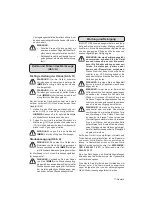
19-English
For your safety
Read all safety instructions and ge-
neral instructions.
Failure to abide
by the safety instructions and general
instructions might result in electrical
shock, a fi re and/or severe injuries.
Keep the safety instructions and ge-
neral instruction safely for future use.
The unit must never be allowed to get
wet or be used in damp conditions.
Always wear safety goggles and
hearing protectors. Always wear a
hair-net if you have long hair. Only
wear tight-fi tting clothing when you
are working.
Always wear industrial safety gloves
fi tting and replacing saw blades.
Safety Instructions
General Power Tool Safety Warnings
WARNING! Read all of the safety warn-
ings and instructions.
Failure to follow the
instructions given in the following may result
in electric shock, fi re and/or serious injury.
KEEP ALL WARNINGS AND INSTRUCTIONS
SAFELY FOR FUTURE REFERENCE
The term “power tool” used in the warnings refers to
your mains-operated (corded) power tool or battery-
operated (cordless) power tool.
1) SAFETY IN THE WORKPLACE
a)
Always keep the workplace clean and
well lit.
Accidents can be caused by clut-
tered or dark workplaces.
b)
Never operate power tools in explosive
atmospheres where fl ammable liquids,
gases or dust are present.
Power tools
generate sparks which may ignite the dust
or fumes.
c)
Keep children and bystanders away
whenever you operate a power tool.
Distractions can cause you to lose control.
2) ELECTRICAL
SAFETY
a)
The power tool's plug must fi t correctly
in the socket. Never modify the plug
in any way. Never use an adapter plug
with earthed (grounded) power tools.
Unmodifi ed plugs and matching outlets will
reduce risk of electric shock.
b)
Avoid bodily contact with earthed or
grounded surfaces such as pipes, radia-
tors, ranges and refrigerators.
There is
an increased risk of electric shock when
your body is earthed or grounded.
c)
Keep power tools out of the rain or wet
conditions.
Water seeping into a power
tool will increase the risk of electric shock.
d)
Do not misuse the cord. Never use the
cord for carrying, pulling or unplugging
the power tool. Keep the cord away from
heat, oil, sharp edges and moving parts.
Damaged or entangled cords increase the
risk of electric shock.
e)
Use an extension cord suitable for out-
door use whenever you operate a power
tool outdoors.
Using an extension cord
suitable for outdoor use reduces the risk
of electric shock.
f)
Use a residual current device (RCD)
protected supply if you cannot avoid
having to operate a power tool in a damp
location.
Use of an RCD reduces the risk
of electric shock.
3) PERSONAL
SAFETY
a)
Stay alert, watch what you are doing and
use common sense whenever you oper-
ate a power tool. Never use a power tool
while you are tired or under the infl uence
of drugs, alcohol or medication.
A mo-
ment of inattention when using a power tool
may result in serious personal injury.
b)
Always wear personal protective equip-
ment. Always wear eye protection.
Wearing personal protective clothing such
as dust mask, non-skid safety shoes, hard
hat, or hearing protection in the appropriate
conditions will reduce personal injuries.
c)
Prevent unintentional starting. Ensure
that the switch is in the off position
before connecting up to a power source
and/or battery pack, picking up or carry-
ing the tool.
Carrying power tools with your
Summary of Contents for HKS 52
Page 4: ...6 11 max ...
Page 5: ...8 9 21 7 10 20 19 22 7 12 18 23 6 ...
Page 6: ...24 26 25 28 24 15 mm 100 mm 27 24 ...
Page 7: ......
Page 8: ...27 27 45 0 ...
Page 9: ...25 29 3 15 16 ...
Page 224: ......
















































